SunTrust 2013 Annual Report Download - page 201
Download and view the complete annual report
Please find page 201 of the 2013 SunTrust annual report below. You can navigate through the pages in the report by either clicking on the pages listed below, or by using the keyword search tool below to find specific information within the annual report.-
 1
1 -
 2
2 -
 3
3 -
 4
4 -
 5
5 -
 6
6 -
 7
7 -
 8
8 -
 9
9 -
 10
10 -
 11
11 -
 12
12 -
 13
13 -
 14
14 -
 15
15 -
 16
16 -
 17
17 -
 18
18 -
 19
19 -
 20
20 -
 21
21 -
 22
22 -
 23
23 -
 24
24 -
 25
25 -
 26
26 -
 27
27 -
 28
28 -
 29
29 -
 30
30 -
 31
31 -
 32
32 -
 33
33 -
 34
34 -
 35
35 -
 36
36 -
 37
37 -
 38
38 -
 39
39 -
 40
40 -
 41
41 -
 42
42 -
 43
43 -
 44
44 -
 45
45 -
 46
46 -
 47
47 -
 48
48 -
 49
49 -
 50
50 -
 51
51 -
 52
52 -
 53
53 -
 54
54 -
 55
55 -
 56
56 -
 57
57 -
 58
58 -
 59
59 -
 60
60 -
 61
61 -
 62
62 -
 63
63 -
 64
64 -
 65
65 -
 66
66 -
 67
67 -
 68
68 -
 69
69 -
 70
70 -
 71
71 -
 72
72 -
 73
73 -
 74
74 -
 75
75 -
 76
76 -
 77
77 -
 78
78 -
 79
79 -
 80
80 -
 81
81 -
 82
82 -
 83
83 -
 84
84 -
 85
85 -
 86
86 -
 87
87 -
 88
88 -
 89
89 -
 90
90 -
 91
91 -
 92
92 -
 93
93 -
 94
94 -
 95
95 -
 96
96 -
 97
97 -
 98
98 -
 99
99 -
 100
100 -
 101
101 -
 102
102 -
 103
103 -
 104
104 -
 105
105 -
 106
106 -
 107
107 -
 108
108 -
 109
109 -
 110
110 -
 111
111 -
 112
112 -
 113
113 -
 114
114 -
 115
115 -
 116
116 -
 117
117 -
 118
118 -
 119
119 -
 120
120 -
 121
121 -
 122
122 -
 123
123 -
 124
124 -
 125
125 -
 126
126 -
 127
127 -
 128
128 -
 129
129 -
 130
130 -
 131
131 -
 132
132 -
 133
133 -
 134
134 -
 135
135 -
 136
136 -
 137
137 -
 138
138 -
 139
139 -
 140
140 -
 141
141 -
 142
142 -
 143
143 -
 144
144 -
 145
145 -
 146
146 -
 147
147 -
 148
148 -
 149
149 -
 150
150 -
 151
151 -
 152
152 -
 153
153 -
 154
154 -
 155
155 -
 156
156 -
 157
157 -
 158
158 -
 159
159 -
 160
160 -
 161
161 -
 162
162 -
 163
163 -
 164
164 -
 165
165 -
 166
166 -
 167
167 -
 168
168 -
 169
169 -
 170
170 -
 171
171 -
 172
172 -
 173
173 -
 174
174 -
 175
175 -
 176
176 -
 177
177 -
 178
178 -
 179
179 -
 180
180 -
 181
181 -
 182
182 -
 183
183 -
 184
184 -
 185
185 -
 186
186 -
 187
187 -
 188
188 -
 189
189 -
 190
190 -
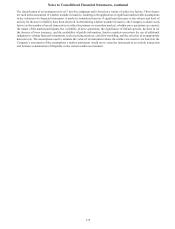 191
191 -
 192
192 -
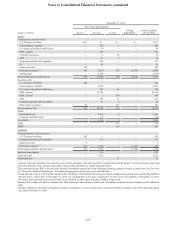 193
193 -
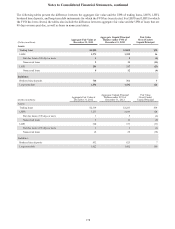 194
194 -
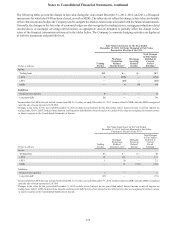 195
195 -
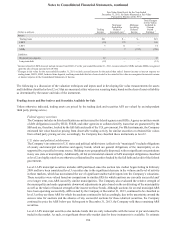 196
196 -
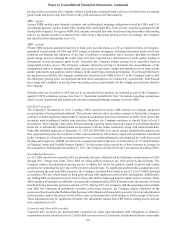 197
197 -
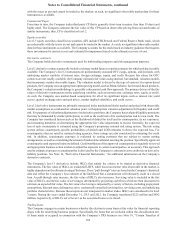 198
198 -
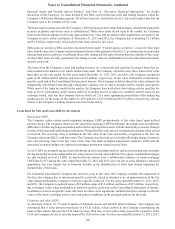 199
199 -
 200
200 -
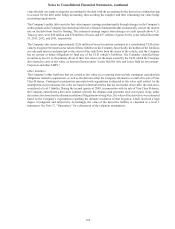 201
201 -
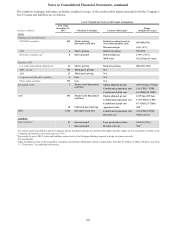 202
202 -
 203
203 -
 204
204 -
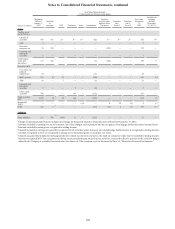 205
205 -
 206
206 -
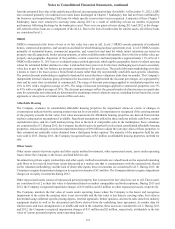 207
207 -
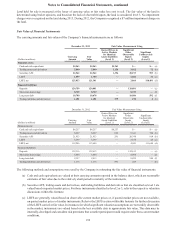 208
208 -
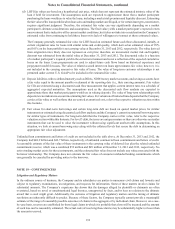 209
209 -
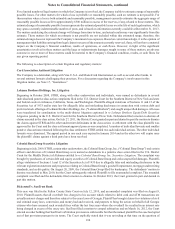 210
210 -
 211
211 -
 212
212 -
 213
213 -
 214
214 -
 215
215 -
 216
216 -
 217
217 -
 218
218 -
 219
219 -
 220
220 -
 221
221 -
 222
222 -
 223
223 -
 224
224 -
 225
225 -
 226
226 -
 227
227 -
 228
228 -
 229
229 -
 230
230 -
 231
231 -
 232
232 -
 233
233 -
 234
234 -
 235
235 -
 236
236
 |
 |
Notes to Consolidated Financial Statements, continued
185
value the debt was made to align the accounting for the debt with the accounting for the derivatives without having
to account for the debt under hedge accounting, thus avoiding the complex and time consuming fair value hedge
accounting requirements.
The Company’s public debt carried at fair value impacts earnings predominantly through changes in the Company’s
credit spreads as the Company has entered into derivative financial instruments that economically convert the interest
rate on the debt from fixed to floating. The estimated earnings impact from changes in credit spreads above U.S.
Treasury rates were $40 million and $78 million of losses and $57 million of gains for the years ended December
31, 2013, 2012, and 2011, respectively.
The Company also carries approximately $256 million of issued securities contained in a consolidated CLO at fair
value to recognize the nonrecourse nature of these liabilities to the Company. Specifically, the holders of the liabilities
are only paid interest and principal to the extent of the cash flows from the assets of the vehicle, and the Company
has no current or future obligations to fund any of the CLO vehicle’s liabilities. The Company classified these
securities as level 2, as the primary driver of their fair values are the loans owned by the CLO, which the Company
also elected to carry at fair value, as discussed herein under “Loans Held for Sale and Loans Held for Investment–
Corporate and other LHFS.”
Other liabilities
The Company’s other liabilities that are carried at fair value on a recurring basis include contingent consideration
obligations related to acquisitions, as well as the derivative that the Company obtained as a result of its sale of Visa
Class B shares. Contingent consideration associated with acquisitions is adjusted to fair value until settled. As the
assumptions used to measure fair value are based on internal metrics that are not market observable, the earn-out is
considered a level 3 liability. During the second quarter of 2009, in connection with its sale of Visa Class B shares,
the Company entered into a derivative contract whereby the ultimate cash payments received or paid, if any, under
the contract are based on the ultimate resolution of litigation involving Visa. The value of the derivative was estimated
based on the Company’s expectations regarding the ultimate resolution of that litigation, which involved a high
degree of judgment and subjectivity. Accordingly, the value of the derivative liability is classified as a level 3
instrument. See Note 17, "Guarantees," for a discussion of the valuation assumptions.
